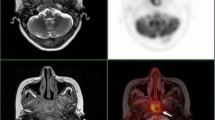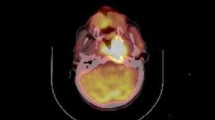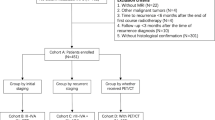Abstract
Objective
The present study aimed to assess the prognostic interest of metabolic and anatomic parameters derived from 2-deoxy-2-[18F]fluoro-d-glucose positron emission tomography/computed tomography ([18F]FDG PET/CT) and head and neck magnetic resonance imaging (HN-MRI) for better management of nasopharyngeal carcinoma (NPC).
Methods
In this study, pre-treatment [18F]FDG PET/CT and HN-MRI parameters of NPC patients diagnosed between January 2017 and December 2018, were prospectively investigated. Correlation between those parameters and 4-year patient’s survival outcomes was evaluated using Kaplan–Meier and Cox-regression analyses.
Results
Our results revealed a significant association between pre-treatment nodal-maximum standardized uptake value (N-SUV max) and N categories (p = 0.01), between pre-treatment node-to-tumor SUV ratio (NTR) and both tumor size (p = 0.01) and N categories (p = 0.009), as well as between metabolic tumor volume (MTV) and both tumor size and NPC overall stage (p < 0.000). In multivariate analyses, pre-treatment N-SUV max, NTR and MTV were significant independent predictors of overall survival, distant metastasis-free survival, and progression-free survival (PFS) (p < 0.05). N-SUV max and MTV were also found to be significant independent predictors of loco-regional recurrence-free survival (p < 0.05), whereas HN-MRI detection of skull-base bone invasion was an independent factor associated with worse PFS in NPC (p = 0.03).
Conclusions
The present study highlights N-SUV max, NTR and MTV derived from [18F]FDG PET/CT, and skull-base bone invasion defined by HN-MRI, as promising metabolic and anatomic prognosis biomarkers for NPC.

Similar content being viewed by others
References
Chua MLK, Wee JTS, Hui EP, Chan ATC. Nasopharyngeal carcinoma. Lancet. 2016;387:1012–24.
Sung H, Ferlay J, Siegel RL, Laversanne M, Soerjomataram I, Jemal A, et al. Global Cancer Statistics 2020: GLOBOCAN estimates of incidence and mortality worldwide for 36 cancers in 185 countries. CA Cancer J Clin. 2021;71:209–49.
Benider A, Harif M, Karkouri M, Quessar A, Sahraoui S, Sqalli S. Registre des Cancers de la Région du Grand Casablanca 2008–2012. [cited 2021 May 26]. https://www.contrelecancer.ma/fr/documents/registre-des-cancers-de-la-region-du-grand-casab-3/
Lo KW, To KF, Huang DP. Focus on nasopharyngeal carcinoma. Cancer Cell. 2004;5:423–8.
Wang KH, Austin SA, Chen SH, Sonne DC, Gurushanthaiah D. Nasopharyngeal carcinoma diagnostic challenge in a nonendemic setting: our experience with 101 patients. Perm. J. 2017;21:16–180
Lee AWM, Sze WM, Au JSK, Leung SF, Leung TW, Chua DTT, et al. Treatment results for nasopharyngeal carcinoma in the modern era: The Hong Kong experience. Int J Radiat Oncol Biol Phys. 2005;61:1107–16.
Yu E, O’Sullivan B, Kim J, Siu L, Bartlett E. Magnetic resonance imaging of nasopharyngeal carcinoma. Expert Rev Anticancer Ther. 2010;10:365–75.
Bossi P, Chan AT, Licitra L, Trama A, Orlandi E, Hui EP, et al. Nasopharyngeal carcinoma: ESMO-EURACAN Clinical Practice Guidelines for diagnosis, treatment and follow-up†. Ann Oncol. 2021;32:452–65.
Liang S-B, Sun Y, Liu L-Z, Chen Y, Chen L, Mao Y-P, et al. Extension of local disease in nasopharyngeal carcinoma detected by magnetic resonance imaging: improvement of clinical target volume delineation. Int J Radiat Oncol Biol Phys. 2009;75:742–50.
Xie C, Liang B, Lin H, Wu P. Influence of MRI on the T, N staging system of nasopharyngeal carcinoma. Zhonghua Zhong Liu Za Zhi. 2002;24:181–4.
Chen Y-K, Cheng R-H, Chi K-H, Liang J-G, Wang S-C, Shen Y-Y, et al. Application of 18F-FDG PET/CT in nasopharyngeal carcinoma. Ann Nucl Med Sci. 2007;20:12.
Su Y, Zhao C, Xie C-M, Lu L-X, Sun Y, Han F, et al. Evaluation of CT, MRI and PET-CT in detecting retropharyngeal lymph node metastasis in nasopharyngeal carcinoma. Ai Zheng. 2006;25:521–5.
Ng S-H, Chan S-C, Yen T-C, Chang JT-C, Liao C-T, Ko S-F, et al. Staging of untreated nasopharyngeal carcinoma with PET/CT: comparison with conventional imaging work-up. Eur J Nucl Med Mol Imaging. 2009;36:12–22.
Lai V, Khong PL. Updates on MR imaging and 18F-FDG PET/CT imaging in nasopharyngeal carcinoma. Oral Oncol. 2014;50:539–48.
Zhou H, Shen G, Zhang W, Cai H, Zhou Y, Li L. 18F-FDG PET/CT for the diagnosis of residual or recurrent nasopharyngeal carcinoma after radiotherapy: a metaanalysis. J Nucl Med. 2016;57:342–7.
Mohandas A, Marcus C, Kang H, Truong M-T, Subramaniam RM. FDG PET/CT in the management of nasopharyngeal carcinoma. Am J Roentgenol. 2014;203:W146–57.
Lin J, Xie G, Liao G, Wang B, Yan M, Li H, et al. Prognostic value of 18F-FDG-PET/CT in patients with nasopharyngeal carcinoma: a systematic review and meta-analysis. Oncotarget. 2017;8:33884–96.
Zhang G-Y, Huang Y, Hu X-F, Chen X-P, Xu T, Liu L-Z, et al. Prognostic value of classifying parapharyngeal extension in nasopharyngeal carcinoma based on magnetic resonance imaging. BioMed Res Int. 2015;2015: e749515.
Zhou G, Mao Y-P, Chen L, Li W-F, Liu L-Z, Sun Y, et al. Prognostic value of prevertebral space involvement in nasopharyngeal carcinoma based on intensity-modulated radiotherapy. Int J Radiat Oncol Biol Phys. 2012;82:1090–7.
Ng WT, Chan SH, Lee AWM, Lau KY, Yau TK, Hung WM, et al. Parapharyngeal extension of nasopharyngeal carcinoma: still a significant factor in era of modern radiotherapy? Int J Radiat Oncol Biol Phys. 2008;72:1082–9.
Chong VFH, Zhou J-Y, Khoo JBK, Chan K-L, Huang J. Correlation between MR imaging-derived nasopharyngeal carcinoma tumor volume and TNM system. Int J Radiat Oncol Biol Phys. 2006;64:72–6.
Fei Z, Chen C, Huang Y, Qiu X, Li Y, Li L, et al. Metabolic tumor volume and conformal radiotherapy based on prognostic PET/CT for treatment of nasopharyngeal carcinoma. Medicine (Baltimore). 2019;98: e16327.
Allal AS, Dulguerov P, Allaoua M, Haenggeli C-A, El Ghazi EA, Lehmann W, et al. Standardized uptake value of 2-[18F] fluoro-2-deoxy-d-glucose in predicting outcome in head and neck carcinomas treated by radiotherapy with or without chemotherapy. JCO Am Soc Clin Oncol. 2002;20:1398–404.
Xie P, Yue J-B, Fu Z, Feng R, Yu J-M. Prognostic value of 18F-FDG PET/CT before and after radiotherapy for locally advanced nasopharyngeal carcinoma. Ann Oncol. 2010;21:1078–82.
Lin P, Min M, Lee M, Holloway L, Forstner D, Bray V, et al. Prognostic utility of (18)F-FDG PET-CT performed prior to and during primary radiotherapy for nasopharyngeal carcinoma: index node is a useful prognostic imaging biomarker site. Radiother Oncol. 2016;120:87–91.
Soret M, Bacharach SL, Buvat I. Partial-volume effect in PET tumor imaging. J Nucl Med Soc Nucl Med. 2007;48:932–45.
Türkölmez Ş, Aksoy SY, Özdemir E, Kandemir Z, Yıldırım N, Özsavran AY, et al. Prognostic significance of standardized uptake value on 18Fluorine-fluorodeoxyglucose positron emission tomography/computed tomography in patients with nasopharyngeal carcinoma. World J Nucl Med. 2017;16:33–8.
Jeong Y, Baek S, Park JW, Joo JH, Kim JS, Lee S-W. Lymph node standardized uptake values at pre-treatment 18F-fluorodeoxyglucose positron emission tomography as a valuable prognostic factor for distant metastasis in nasopharyngeal carcinoma. Br J Radiol. 2017;90:20160239.
John C, Venkatasai J, Kondaveeti SS, Murali A, Periakaruppan G, et al. Prognostic significance of metabolic tumour volume and maximum standard uptake value of fluor-18-fluorodeoxyglucose positron emission tomography with computed tomography in nasopharyngeal carcinoma. Contemp Oncol (Pozn). 2021;25:153–9.
Chen W-H, Tang L-Q, Zhang L, Chen Q-Y, Guo S-S, Liu L-T, et al. Combining plasma Epstein–Barr virus DNA and nodal maximal standard uptake values of 18F-fluoro-2-deoxy-d-glucose positron emission tomography improved prognostic stratification to predict distant metastasis for locoregionally advanced nasopharyngeal carcinoma. Oncotarget. 2015;6:38296–307.
Chung HH, Cheon GJ, Kim J-W, Park N-H, Song YS. Prognostic importance of lymph node-to-primary tumor standardized uptake value ratio in invasive squamous cell carcinoma of uterine cervix. Eur J Nucl Med Mol Imaging. 2017;44:1862–9.
Cirak K. Are ratio of lymph node to primary focus SUV-max and PET/CT 18FDG standard uptake value of lymph nodes meaningful in staging non-small cell lung cancer? UHOD. 2011;21:217–22.
Chen P-J, Yap W-K, Chang Y-C, Tseng C-K, Chao Y-K, Hsieh JC-H, et al. Prognostic value of lymph node to primary tumor standardized uptake value ratio in unresectable esophageal cancer. BMC Cancer. 2020;20:1–9.
Hung T-M, Fan K-H, Kang C-J, Huang S-F, Lin C-Y, Ho AT-Y, et al. Lymph node-to-primary tumor standardized uptake value ratio on PET predicts distant metastasis in nasopharyngeal carcinoma. Oral Oncol. 2020;110:104756.
Yi-Liang Shen E, Hung T-M, Tsan D-L, Cheng N-M, Kang C-J, Huang S-F, et al. Utilization of the lymph node-to-primary tumor ratio of PET standardized uptake value and circulating epstein–barr virus DNA to predict distant metastasis in nasopharyngeal carcinoma. Radiotherapy and Oncology. 2022;11:S0167-8140(22)00240–7
Li Q, Zhang J, Cheng W, Zhu C, Chen L, Xia F, et al. Prognostic value of maximum standard uptake value, metabolic tumor volume, and total lesion glycolysis of positron emission tomography/computed tomography in patients with nasopharyngeal carcinoma. Medicine (Baltimore). 2017;96: e8084.
Xie P, Yue J-B, Zhao H-X, Sun X-D, Kong L, Fu Z, et al. Prognostic value of 18F-FDG PET-CT metabolic index for nasopharyngeal carcinoma. J Cancer Res Clin Oncol. 2010;136:883–9.
Li Q, Zhang J, Cheng W, Zhu C, Chen L, Xia F, et al. Prognostic value of maximum standard uptake value, metabolic tumor volume, and total lesion glycolysis of positron emission tomography/computed tomography in patients with nasopharyngeal carcinoma: a systematic review and meta-analysis. Medicine (Baltimore). 2017;96: e8084.
Feng Y, Cao C, Hu Q, Chen X. Grading of MRI-detected skull-base invasion in nasopharyngeal carcinoma with skull-base invasion after intensity-modulated radiotherapy. Radiat Oncol. 2019;14:10.
Mo H-Y, Sun R, Sun J, Zhang Q, Huang W-J, Li Y-X, et al. Prognostic value of pretreatment and recovery duration of cranial nerve palsy in nasopharyngeal carcinoma. Radiat Oncol. 2012;7:149.
Huang W, Quan T, Zhao Q, Li S, Cai Y, Zhou J, et al. MRI of nasopharyngeal carcinoma: parapharyngeal subspace involvement has prognostic value and influences T-staging in the IMRT era. Eur Radiol. 2021;32:262–71.
Tang L-L, Sun Y, Mao Y-P, Chen Y, Li W-F, Chen L, et al. Prognostic value of parapharyngeal extension in nasopharyngeal carcinoma treated with intensity modulated radiotherapy. Radiother Oncol. 2014;110:404–8.
Nishioka T, Shirato H, Kagei K, Abe S, Hashimoto S, Ohmori K, et al. Skull-base invasion of nasopharyngeal carcinoma: magnetic resonance imaging findings and therapeutic implications. Int J Radiat Oncol Biol Phys. 2000;47:395–400.
Li Q, Wang T, Huang Y, Li Q, Liu P, Grimm R, et al. Whole-tumor histogram and texture imaging features on magnetic resonance imaging combined with Epstein–Barr virus status to predict disease progression in patients with nasopharyngeal carcinoma. Front Oncol. 2021. https://doi.org/10.3389/fonc.2021.610804.
Li H-J, Hu Y-Y, Huang L, Zhou J, Li J-J, Xie C-B, et al. Subclassification of skull-base invasion for nasopharyngeal carcinoma using cluster, network and survival analyses: a double-center retrospective investigation. Radiother Oncol. 2019;134:37–43.
Becker M, Zaidi H. Imaging in head and neck squamous cell carcinoma: the potential role of PET/MRI. Br J Radiol. 2014;87:20130677.
Qin C, Liu F, Huang J, Ruan W, Liu Q, Gai Y, et al. A head-to-head comparison of 68Ga-DOTA-FAPI-04 and 18F-FDG PET/MR in patients with nasopharyngeal carcinoma: a prospective study. Eur J Nucl Med Mol Imaging. 2021;48:3228–37.
Acknowledgements
Acknowledgments We are grateful to Pr Nadia Benchakroun, Pr Zineb Bouchbika, Pr Souha Sahraoui, Pr Abdellatif Benider and the entire staff of Mohammed VI Center for Cancer Treatment, Ibn Rochd University Hospital for patients’ recruitment and assistance of patient’s appointments. Our gratitude goes also to Dr Jaafar Ibnohoud and Dr. Ibrahim Idbelkass from Nuclear Medicine Department for assistance in [18F]FDG PET/CT data files’ management; and Wafaa khaali from laboratory of Viral Oncology, Institut Pasteur du Maroc, for reviewing the final manuscript.
Funding
This study was funded by the Institut de Recherche sur le Cancer (IRC) Ref: 201932, and the Centre National de l'Energie, des Sciences et des Techniques Nucléaires (CNESTEN).
Author information
Authors and Affiliations
Corresponding author
Additional information
Publisher's Note
Springer Nature remains neutral with regard to jurisdictional claims in published maps and institutional affiliations.
Supplementary Information
Below is the link to the electronic supplementary material.
Rights and permissions
About this article
Cite this article
Gihbid, A., Cherkaoui Salhi, G., El Alami, I. et al. Pretreatment [18F]FDG PET/CT and MRI in the prognosis of nasopharyngeal carcinoma. Ann Nucl Med 36, 876–886 (2022). https://doi.org/10.1007/s12149-022-01770-4
Received:
Accepted:
Published:
Issue Date:
DOI: https://doi.org/10.1007/s12149-022-01770-4




